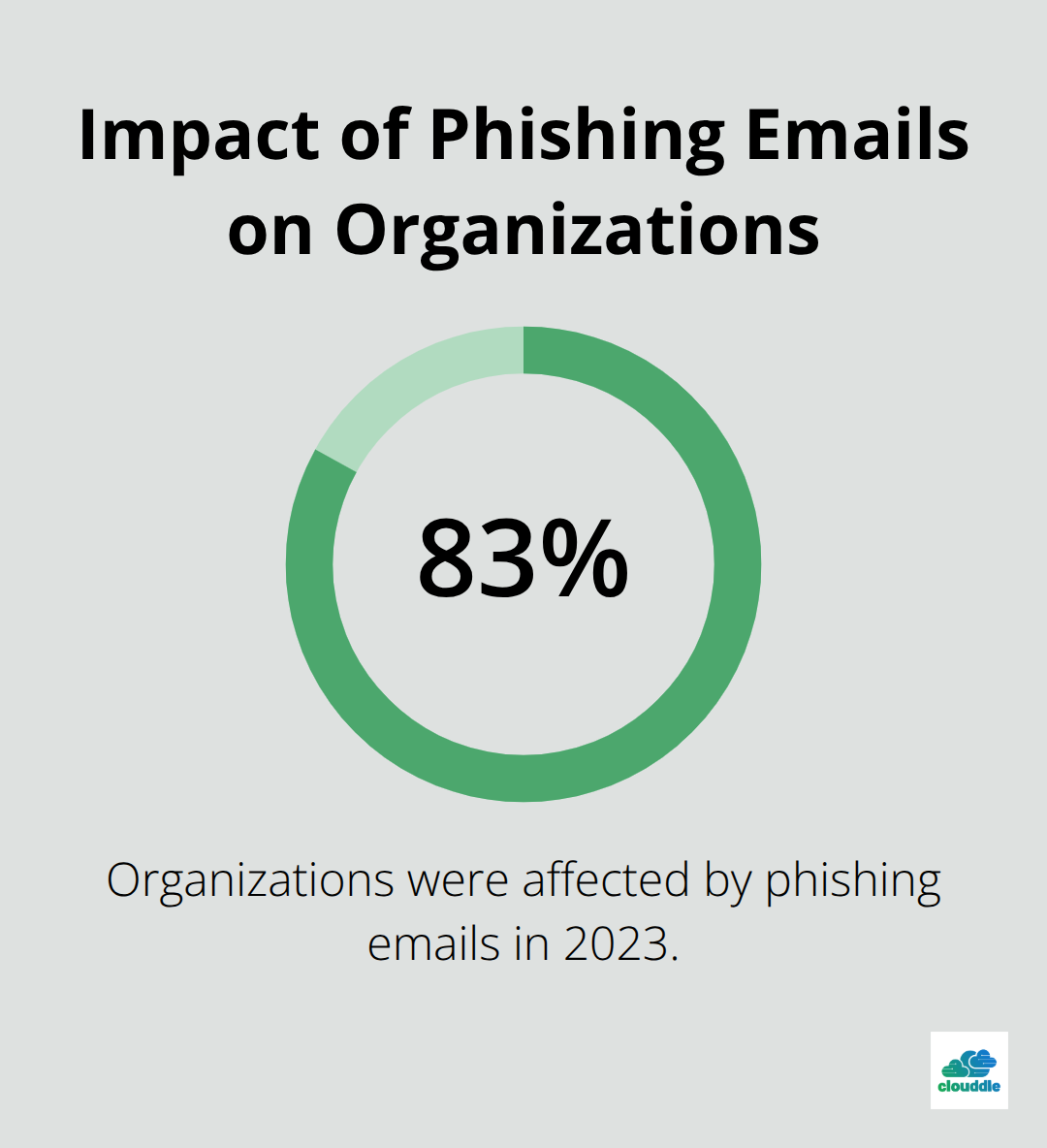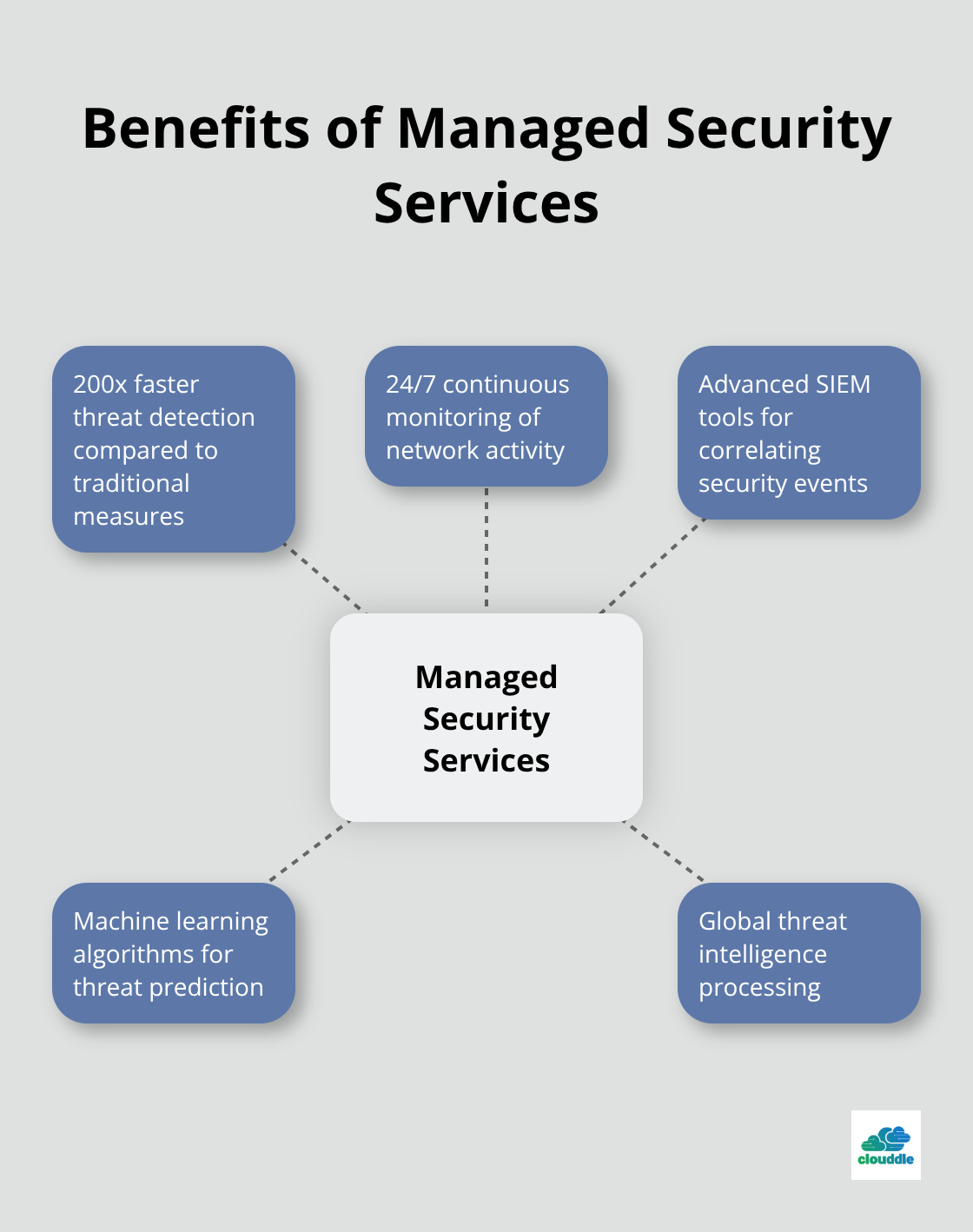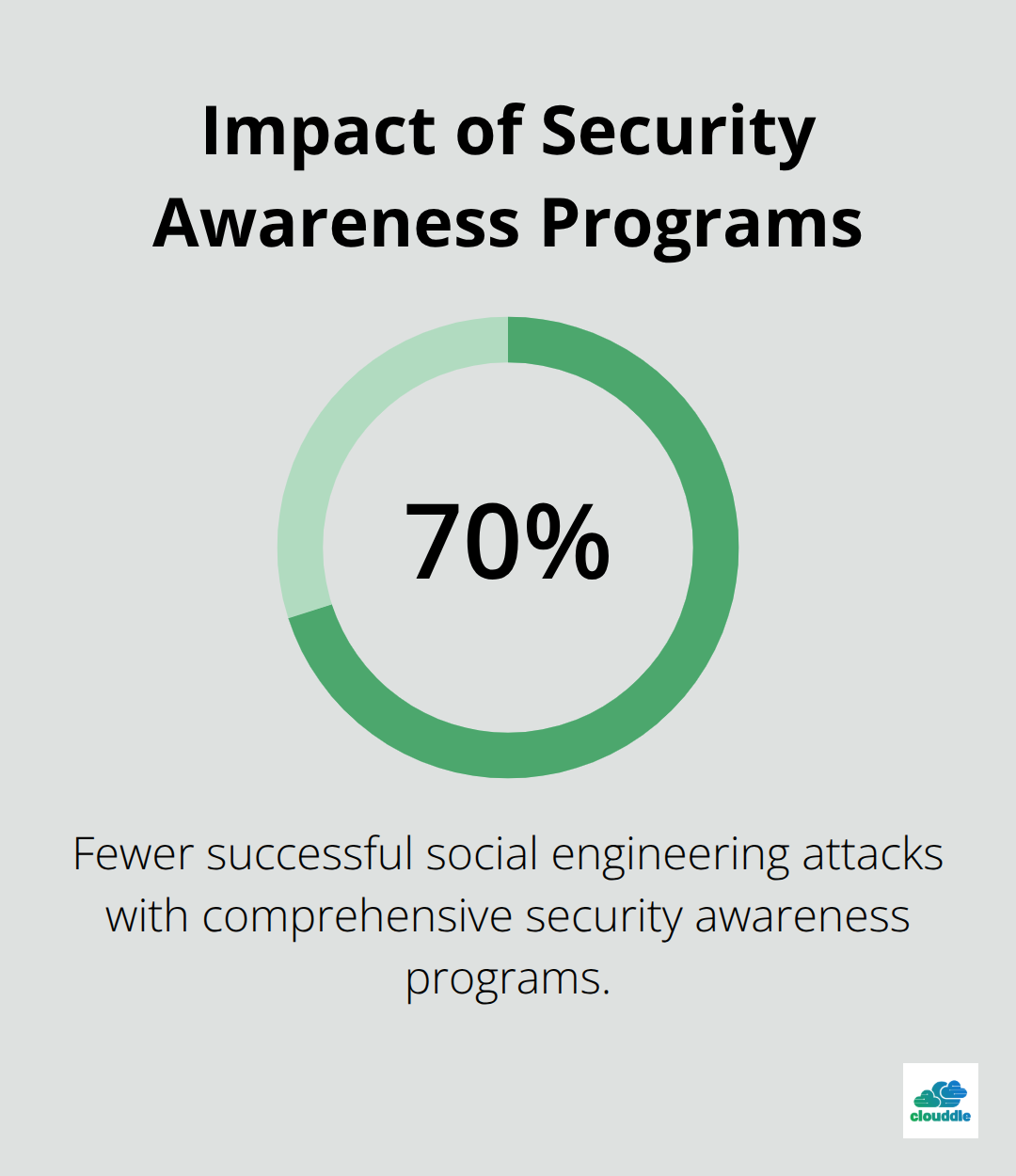Cyber attacks cost businesses an average of $4.45 million per breach in 2023, according to IBM’s Cost of a Data Breach Report. Small and medium businesses face even higher risks, with 60% closing within six months of a major security incident.
We at Clouddle see companies struggling with outdated security measures that can’t match today’s sophisticated threats. Managed IT services for cybersecurity offer 24/7 protection that most internal teams simply can’t provide.
What Cybersecurity Threats Target Your Business
Organizations in the U.S. are the businesses most likely to be affected by ransomware, accounting for 47% of attacks in 2023, with cybercriminals targeting businesses of all sizes through sophisticated methods. Phishing emails remain the most common entry point, affecting 83% of organizations last year according to Proofpoint’s State of the Phish report.

These attacks often lead to business email compromise, where criminals impersonate executives to steal funds or sensitive data. Distributed denial-of-service attacks have also surged, with Cloudflare reporting a 79% increase in DDoS incidents that target small businesses specifically.
Financial Damage Extends Beyond Initial Losses
Data breaches create costs that extend far beyond immediate recovery expenses. Regulatory fines under GDPR can reach 4% of annual revenue, while HIPAA violations cost healthcare organizations an average of $10.9 million per incident. Downtime costs average $5,600 per minute for enterprise businesses (smaller companies face proportionally higher impacts). Legal fees, forensic investigations, and customer notification requirements add another $1.2 million on average to total breach costs.
Traditional Security Methods Fail Against Modern Threats
Signature-based antivirus software catches only 45% of new malware variants, which leaves businesses exposed to zero-day exploits and advanced persistent threats. Firewall configurations from five years ago cannot handle today’s encrypted traffic analysis needs, with 70% of malicious traffic now using HTTPS encryption. Most internal IT teams lack specialized cybersecurity training and spend only 23% of their time on security tasks (according to the SANS Institute). This reactive approach leaves critical vulnerabilities unpatched for an average of 102 days.
The Gap Between Threats and Protection Widens
Cybercriminals now use artificial intelligence to create more convincing phishing campaigns and automate attack sequences. Advanced persistent threats often remain undetected for 21 to 280 days before discovery, depending on the target’s security posture. Meanwhile, businesses continue to rely on outdated security frameworks that cannot adapt to these evolving tactics. This mismatch between threat sophistication and defense capabilities creates the perfect storm for successful cyber attacks. Managed IT services bridge this gap through specialized expertise and advanced security technologies that most businesses cannot afford to implement independently.
How Managed IT Services Strengthen Your Cybersecurity
Managed IT services transform cybersecurity through continuous monitoring that internal teams cannot match. Security Operations Centers operated by managed providers track network activity continuously, compared to typical internal IT teams that monitor systems only during business hours. Gartner research shows that organizations that use managed security services detect threats 200 times faster than those that rely on traditional security measures. These providers use advanced SIEM tools that correlate millions of security events daily and identify patterns that human analysts would miss.

Machine learning algorithms process threat intelligence from global sources and enable prediction of attack vectors before they strike your network.
Expert Teams With Specialized Training
Managed IT providers employ certified cybersecurity professionals who dedicate 100% of their time to security tasks, unlike internal IT staff who split attention between multiple responsibilities. These specialists hold certifications like CISSP, CEH, and GCIH that cost $15,000 annually per employee to maintain. Teams receive continuous training on emerging threats and attack methodologies that evolve weekly. Incident response specialists can contain breaches within 4 hours versus the industry average of 280 days for unmanaged environments. Security analysts who work for managed providers handle 50-100 security incidents monthly and develop expertise that internal teams rarely achieve.
Automated Security Management Reduces Risk Windows
Patch management through managed services applies critical security updates within 24-48 hours of release, compared to the 102-day average for organizations that manage updates internally. Automated vulnerability scans run continuously and identify security gaps before attackers can exploit them. Configuration management tools maintain security baselines across all systems and prevent the security drift that affects 78% of unmanaged networks (according to Ponemon Institute research). These providers implement Zero Trust architectures that verify every connection attempt and reduce successful breach rates by 68% compared to perimeter-based security models.
Advanced Technology Access Without Capital Investment
Managed providers deploy enterprise-grade security tools that most businesses cannot afford independently. These solutions include next-generation firewalls, behavioral analytics platforms, and threat intelligence feeds that cost $500,000+ annually for mid-sized organizations. Providers spread these costs across multiple clients and make advanced protection accessible to smaller businesses. Security orchestration platforms automate incident response workflows and reduce manual intervention requirements by 85%. This technology advantage allows managed services to stop attacks that would overwhelm traditional security measures and creates a foundation for the comprehensive security services that protect your business operations.
Key Cybersecurity Services Offered by Managed IT Providers
Managed IT providers deliver network security through next-generation firewalls that inspect encrypted traffic and block 99.7% of known threats according to Fortinet research. These systems perform deep packet inspection on all network communications and identify malicious patterns that traditional firewalls miss. Intrusion detection systems monitor network traffic continuously and alert security teams within 3 minutes of suspicious activity. Managed providers configure firewall rules that adapt automatically to new threat intelligence and block connection attempts from known malicious IP addresses. Network segmentation isolates critical systems from general user networks, addressing inadequate access controls that cause 65% of organizations to experience cybersecurity breaches.
Data Backup and Disaster Recovery Solutions
Data backup through managed services creates multiple recovery points daily and stores copies in geographically separate locations that ransomware cannot reach. These providers test backup integrity weekly and maintain recovery time objectives of 4 hours for critical systems versus 48-72 hours for businesses that manage backups internally. Immutable backup storage prevents ransomware from encrypting recovery files and enables complete system restoration even during active attacks. Disaster recovery plans include communication protocols, vendor contacts, and step-by-step procedures that reduce recovery time by 67% compared to organizations without formal plans. Recovery testing occurs quarterly to verify that backup systems function correctly and staff can execute restoration procedures under pressure.
Employee Security Awareness Programs
Employee security training through managed providers uses simulated phishing campaigns that test staff monthly to help employees understand what phishing looks like and how to respond when targeted. These programs track individual employee progress and provide targeted training for staff who fail simulated attacks. Security awareness modules cover password management, social engineering tactics, and incident reporting procedures that employees actually use during real attacks. Training includes hands-on exercises where employees practice identification of suspicious emails and response to security incidents. Organizations that implement comprehensive security awareness programs see 70% fewer successful social engineering attacks (according to KnowBe4 research), while untrained staff remain the primary attack vector for 82% of data breaches.

Final Thoughts
Managed IT services for cybersecurity deliver measurable protection that internal teams cannot match. Organizations reduce breach detection time from 280 days to under 4 hours while accessing enterprise-grade security tools worth $500,000+ annually. The financial benefits are clear: establishing an in-house SOC costs $300,000-$1,100,000 initially plus $1,200,000-$3,900,000 in annual staffing (while managed services provide comprehensive protection for $15,000-$50,000 monthly).
We at Clouddle see businesses transform their security posture through managed services that combine 24/7 monitoring, expert incident response, and automated threat prevention. Your next step involves assessment of current security gaps and selection of a provider that offers continuous monitoring, regular vulnerability assessments, and proven incident response capabilities. The right managed provider will adapt security measures to match your specific business requirements.
Clouddle provides managed IT services that include networking, security, and 24/7 support, which enables businesses to focus on growth while maintaining robust cybersecurity protection. Our team works with companies to implement comprehensive security frameworks without the overhead of internal security teams. Contact us to learn how managed services can strengthen your organization’s defense against evolving cyber threats.


